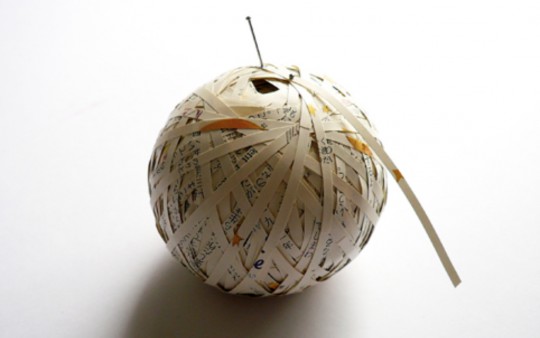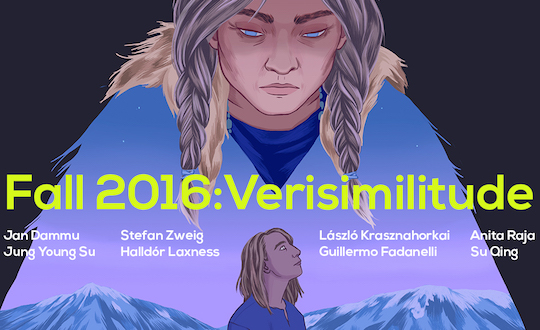Last week, we launched “Verisimilitude,” our star-studded Fall 2016 edition. Since then, we’ve been overwhelmed by the critical reception: A Public Space called the issue “a gold mine of work from 31 countries” while The Chicago Review of Books proclaimed it “f**ing gorgeous.” Among the never-before-published work by both well known and emerging translators, writers, and visual artists we presented in this quarterly issue, Anita Raja’s essay on translation made The Literary Hub‘s Best of the Week roundup. Thank you so much and do please keep spreading the word so we can connect our authors with even more readers! This week, to guide your exploration of the new issue, some of our editors contribute highlights from their respective sections. Follow them from Ireland to Iraq to Mexico to Korea and back again.

Tactile Translations, Stefana McClure. Review: Eva Heisler, Visual Editor.
Using sources as various as a Japanese translation of The Little Prince, Samuel Beckett’s Molloy, or a U.S. government redacted report on “enhanced interrogation techniques,” artist Stefana McClure slivers printed matter and re-employs it as material with which to construct her enigmatic objects: stones wrapped in paper; a ball wound of the paper shreds of a novel; a nearly black “drawing” knit from redacted texts. Carmen Hermo’s conversation with McClure delves into the thinking and process behind the artist’s “tactile translations.”
Four Poems, Jan Dammu, tr. Suneela Mubayi. Review: Aditi Machado, Poetry Editor.
The modernist poet is an alluring, mercurial figure. Certain features (the enigmatic image, the erudition, a worldly sort of disenchantment) are shared, but different languages and literatures shape those attributes into something distinct, unrepeatable. Iraqi poet Jan Dammu’s modernism embraces both a byzantine sort of questioning—“Should one take refuge in Narcissus (or Bacchus) / for the sake of decoding the talismanic rose / or the butterflies that flit / in the corridors opened by our sleep / that fossilize us?”—and stark, declarative expressions of alienation: “Here I am, en route to practice my humanity” or “Here I am with / an apple / and that suffices.” Dammu belonged to the Kirkuk group of poets and not much of his work has survived or been translated. It is a wonderful gift that Suneela Mubayi has brought into English these dark and dazzling poems.
Stephanie Boland on Máirtín Ó Cadhain’s Graveyard Clay and The Dirty Dust. Review: Ellen Jones, Criticism Editor.
My highlight from this issue’s criticism section is Stephanie Boland’s penetrating comparative review of two translations of Máirtín Ó Cadhain’s Cré na Cille. This Irish language tour de force, compared to Joyce’s Finnegans Wake and first published in 1949, did not appear in English until last year, when Yale University Press released not one but two translations. Stephanie, a writer and editor based in London, weighs up the relative merits of Alan Titley’s translational approach (his version is titled The Dirty Dust) versus Liam Mac Con Iomaire’s and Tim Robinson’s approach (they plumped for Graveyard Clay). Interweaving personal reflections on her own efforts to teach herself Irish, she traces the fraught relationship between spoken and written registers of Irish, and offers astute readings of the two versions in the light of contemporary language politics.
Excerpts from In Praise of Vagrancy by Guillermo Fadanelli, tr. Alice Whitmore. Review: Joshua Craze, Nonfiction Editor.
The excerpts from Guillermo Fadanelli’s In Praise of Vagrancy that Alice Whitmore has wonderfully translated for our October issue struck me as exemplary of the craft of the essay. Moving easily between meditations on umbrellas and Gadamer’s understanding of the task of philosophy, the lightness of Fadanelli’s work reminded me of Adorno’s description of the essay in “The Essay as Form.” Suspicious of the systematic, the essay “reflects a childlike freedom that catches fire, without scruple, on what others have already done.” The world is Fadanelli’s play-thing, and he holds it up to the light, for the reader to inspect. At its best, the essay can intensify our experience of living; Fadanelli’s work does just this.
“Aficionados” by Jung Young Su, tr. Anton Hur. Review: Lee Yew Leong, Fiction Editor.
What can go wrong in the life of an adjunct professor-translator? Plenty, it seems. Jung Young Su’s incredibly well-crafted short story is narrated by an obnoxious academic who dreams of ditching academia (and his girlfriend) for Granada, to translate Lope de Vega. But pride comes before a fall in this tale of translator hubris. Along the way, as the story builds up vertigidinously to the great fall, Paul Ricœur and Harold Bloom are invoked, translation theories are discussed, and academic tantrums are thrown. It’s all great fun—but students of comedic writing might also dissect this exemplary model for its many lessons on craft. Kudos to Anton Hur for the terrific execution in English; I’ll look forward to the short story collection when it is finally translated and published.
*****
Read More from the Asymptote team!

